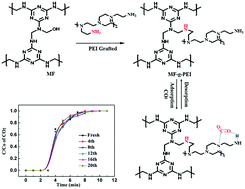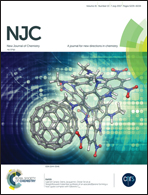The preparation of a porous melamine–formaldehyde adsorbent grafted with polyethyleneimine and its CO2 adsorption behavior
Abstract
A porous amino resin melamine–formaldehyde (MF) with a high content of hydroxymethyl groups was prepared via the polycondensation of an excess of formaldehyde with melamine. Polyethylene imine (PEI) was then grafted onto the porous amino resin via a Mannich reaction between the active hydroxymethyl groups on the MF resin and the amino group on PEI to synthesize a solid amine adsorbent (MF-g-PEI). A large amount of hydroxymethyl groups were generated on the synthesized amino resin due to the excess formaldehyde used in the polycondensation reaction, which will provide abundant active sites to firmly combine with PEI and thus, enhance the stability of the MF-g-PEI adsorbent. The BET surface area and the pore volume of MF-g-PEI prepared using the optimal conditions were 460 m2 g−1 and 0.76 cm3 g−1, respectively. The CO2 adsorption capacity of MF-g-PEI, with a PEI loading of 11.35% can reach 1.32 mmol g−1 at 10 °C, while its amine utilization efficiency can reach up to 48.9%. The adsorbents also exhibited significantly improved adsorption kinetics and regeneration performance. This work provides a novel method that can achieve a promising solid amine adsorbent by directly grafting PEI onto porous material in the absence of an intermediate.



 Please wait while we load your content...
Please wait while we load your content...